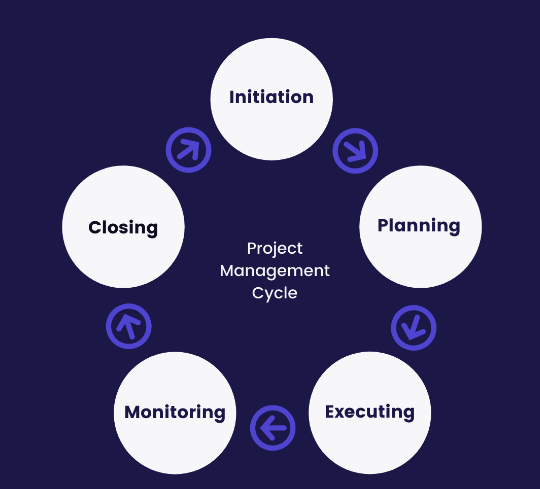
IT Project Management Best Practices (Image by Elmhurst University)

IT Project Management Best Practices (Image by Elmhurst University)
IT infrastructure project management best practices are key factors in determining whether the business technology framework is robust and seamlessly aligned with business objectives.
And yes, this best practice approach is vital for maintaining competitiveness and efficiency in a rapidly evolving digital landscape.
Effective project management in IT infrastructure involves clear communication, precise planning, and thorough risk assessment.
These practices help in minimizing disruptions and ensuring that IT projects are delivered on time and within budget, which is essential for achieving business goals.
Moreover, it fosters an environment where technology serves as a catalyst for growth and innovation, rather than being a bottleneck. Understanding these best practices is key to leveraging technology as a strategic asset.
For those keen to explore how these principles translate into real-world success and drive business transformation, a deeper dive into the subject promises valuable insights.
So, let’s be tuned for a comprehensive discussion on the pivotal role of best practices in IT infrastructure project management below.
Navigating the tricky waters of technology and making sure it aligns with your business goals is a challenge, isn’t it?
It’s like a delicate dance that requires a smart, strategic touch that mixes sharp analytical thinking with some real-world smarts.
And guess what? One of the most important steps in this dance is adhering to best practices. Now, when we talk about best practices for managing IT infrastructure projects, we’re really talking about a few key things.
The best practices help ensure that your IT projects don’t just wander off, but stay tightly aligned with what your business is all about.
They’re about using resources wisely, managing risk like a pro, maintaining quality, keeping everyone on the same page, and making sure your IT setup can grow and adapt as your business does.
Yes, best practices are what transform your IT projects from just another line item to real power players in your business strategy.
In IT infrastructure project management, imagine a scenario where the direction of the project seems unclear.
This lack of clarity is a common obstacle that leads to misaligned efforts and resources.
So, we need to recognize the power of clear project goals. Defining these goals transforms chaos into focus and guides teams toward a unified goal.
The importance of clear project goals cannot be underestimated. They serve as the project’s navigation system, providing direction and purpose.
Without them, projects can easily veer off course, wasting time and resources on efforts that don’t align with business needs.
The strategy for ensuring alignment with organizational objectives involves a few key steps.
First, thoroughly understand the business’s core goals and challenges. This understanding forms the foundation for setting project objectives.
Next, define these objectives with precision and clarity. They should be specific, measurable, achievable, relevant, and time-bound (SMART).
This clarity helps in creating a roadmap for the project, outlining what success looks like and how it contributes to the larger business strategy. Finally, it’s critical to maintain open channels of communication.
Regularly reviewing and refining these objectives in light of new insights or changes in the business environment ensures that they remain relevant and aligned with the organization’s evolving goals.
This approach streamlines project management and also guarantees that IT infrastructure projects will be valuable assets in the achievement of business success.
When you set out to build a complex IT infrastructure, the situation is ripe with potential: new technology deployments and the promise of improved efficiency.
But there’s one major obstacle: the daunting complexity of the project. Without careful planning, the project could easily go off track, resulting in cost overruns, delays and unmet objectives.
After all, we know that comprehensive project planning isn’t just helpful – it’s essential.
This planning starts with clearly defining the scope of the project. It’s like drawing boundaries on a map to make sure everyone knows the extent of the territory to be covered.
Then comes resource allocation, which involves not only identifying the resources needed, but also understanding how to use them efficiently.
This step is critical to ensuring that the project has everything it needs, from people to technology, without wasting resources.
Then we have timeline establishment, which is like setting up signposts along the journey, marking key milestones and deadlines. This helps to track progress and ensure that the project stays on schedule.
Risk management, however, is perhaps the most critical. By identifying potential risks and developing strategies to mitigate them, you can prevent small issues from becoming project-threatening challenges.
So, comprehensive project planning in IT infrastructure project management is like preparing for a challenging expedition.
You requires careful consideration of every aspect, from scope and resources to timelines and risks, to ensure that the journey is successful and the destination is reached as planned.
Effective communication serves as the foundation for project success. This practice is characterized by establishing clear and open channels of communication among all project participants, from team members to stakeholders.
Effective communication also serves as a vital link between the various elements of the IT infrastructure management process.
Effective communication ensures that the entire process is cohesive, responsive, and aligned with the organization’s goals.
This clarity helps in aligning the team’s efforts with the project’s goals, reducing the likelihood of missteps or misinterpretations.
Moreover, effective communication fosters a collaborative environment. It encourages team members to share ideas, provide feedback, and collectively solve problems.
This collaboration is crucial in navigating the complexities of IT projects, where diverse expertise and perspectives can significantly enhance problem-solving and innovation.
To maintain effective communication, regular meetings, clear documentation, and the use of collaborative tools are essential.
These practices not only keep the team connected but also provide a transparent record of decisions and discussions.
As a result, effective communication not only streamlines project management but also contributes to building a strong, cohesive team capable of overcoming the unique challenges of IT infrastructure projects.

Adopting agile methodologies for IT infrastructure project management is a strategic move that brings several benefits.
Agile methodologies are defined by their iterative and adaptive nature, which is in stark contrast to traditional, rigid project management approaches.
The benefit of this adaptability is the ability to respond swiftly to changes – be it in technology, market demands, or project requirements.
This responsiveness ensures that IT projects remain relevant and effective, even in a rapidly evolving tech landscape.
Agile methodologies enable project teams to make incremental improvements through successive iterations, allowing for continuous refinement and adjustment.
Another key benefit of agile is enhanced collaboration and communication. Agile’s emphasis on regular team interactions and client involvement keeps everyone on the same page, fostering a transparent and dynamic work environment.
This approach not only improves team morale but also leads to more innovative solutions and a deeper understanding of the project’s goals.
One of the most significant challenges in IT infrastructure project management is the uncertainty and risks that come with complex technological projects.
These risks, if not managed effectively, can lead to project delays, cost overruns, and even complete failure.
The solution lies in robust risk management, a pivotal aspect of best practices in project management.
The importance of identifying potential risks at the outset cannot be overstated. This process involves a thorough analysis of what could go wrong, from technical glitches to budget issues or resource constraints.
Once risks are identified, the next step is to develop strategies to mitigate them. This might include contingency planning, allocating extra resources, or adjusting project timelines.
A well-thought-out risk management plan not only prepares the project for potential problems but also ensures that these issues can be addressed quickly and efficiently if they arise.
Creating a robust risk management plan requires continuous monitoring and adaptation. As the project progresses, new risks may emerge, necessitating ongoing assessment and adjustment of the risk management strategies.
By prioritizing risk management, IT projects stand a far better chance of staying on track and meeting their objectives, regardless of the challenges they encounter.
Another common problem in IT infrastructure project management is a lack of cohesion and synergy among team members.
This disconnect can lead to miscommunication, inefficiency, and ultimately, project setbacks.
The real issue is collaborative team mobilization, a best practice that is critical to project success.
Assembling a team with diverse skills and expertise is just the beginning. The real challenge is fostering a collaborative spirit that effectively leverages the strengths of each member.
This requires strategies such as regular team meetings, clear role definitions, and open communication channels.
These practices not only clarify expectations, but also build a sense of unity and purpose.
Encouraging open dialogue and knowledge sharing among team members can also improve problem solving and innovation.
Effective team mobilization and coordination requires ongoing effort. It’s a matter of creating an environment in which collaboration is not only encouraged, but becomes a natural part of the way the team operates.
When each team member feels valued and an integral part of the project, the team becomes more than the sum of its parts. The team’s combined expertise and concerted effort drive the project to success.
Continuous monitoring and adjustment is a best practice in IT infrastructure project management because of its proactive approach.
This practice is characterized by continuous monitoring of project progress, coupled with the flexibility to adjust strategies as needed.
Continuous monitoring allows project managers to identify and address issues early, preventing them from escalating into major problems.
This real-time visibility provides a more accurate assessment of the project’s health, enabling more informed decision making.
The result of these benefits is a project that stays in sync with changing requirements and circumstances.
In addition, continuous monitoring and adjustments ensure the IT infrastructure management remains relevant and effective over time.
This directly contributes to the overall health and efficiency of the organization’s IT infrastructure.
So, adapting to changes not only keeps the project relevant, but also ensures that it continues to align with the organization’s evolving goals.
This approach leads to increased efficiency, reduced risk and, ultimately, a higher probability of project success.
Projects become dynamic entities that can pivot quickly in response to new challenges and opportunities, delivering greater value to the organization.
The landscape of 2024 requires a blend of clarity, agility, and collaboration. With a focus on the seven practices above, your organization can navigate the complexities of IT projects with greater ease and effectiveness.
Creating a dynamic environment where goals are clear, plans are thorough, communication is effective, methodologies are agile, risks are managed, teams are collaborative, and monitoring is continuous is more than just following a set of rules.
In the ever-evolving world of IT, this approach isn’t just a recommendation; it’s a necessity.
With these best practices in place, organizations can be confident their IT infrastructure projects are not only successful, but also resilient in the face of change.
So let’s embrace these practices-not as a checklist, but as a mindset-to drive our IT projects to excellence in 2024 and beyond.